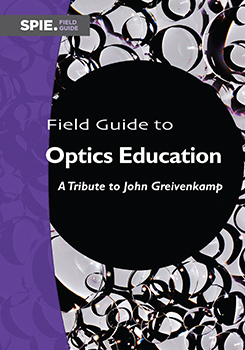A Shared Passion for Optics Education: John Greivenkamp and Harrison Barrett
Kyle Myers
Puente Solutions, LLC, USA
John Greivenkamp was a passionate educator, recognized for his outstanding teaching by SPIE awarding him the 2017 SPIE María J. Yzuel Educator Award. John and I were mentored by another passionate educator, arguably one of the best in optical sciences, Dr. Harrison H. Barrett of the University of Arizona’s College of Optical Science. Harry’s impact on imaging science was largely due to his dedication to teaching and his mentoring of graduate students. His teaching extended far beyond the classroom, too. His questions at the microphone during a conference were known for being mini-tutorials that brought clarity and depth to the discussion. His many lectures at conferences and institutions around the world built a far-reaching community of imaging science enthusiasts. During his years at the University of Arizona, Harry taught more than 20 different courses and was the advisor for over 75 graduate students. When students would ask him whether they should work in industry, national labs, or academia, Harry would quickly tell them that it depends on how they personally measure success—as for himself, he kept score by the number of dissertations produced in his group, not by money.
Below are some of the lessons John and I learned from Harry Barrett regarding how to be an outstanding teacher, mentor, and influencer in imaging and optical sciences:
1. Keep teaching fresh. Harry brought great enthusiasm to each course he taught and put considerable effort into his preparations for each class. Regardless of the number of times he taught the material, he insisted on generating new teaching notes for each class to ensure that his presentations were fresh.
2. Be rigorous and strive for clarity. Harry brought rigor to all the courses he taught and the research he led. His books paid incredible attention to detail both in his efforts to be comprehensive regarding the topics he covered as well as attention to minute aspects of notation. Harry was a master of theoretical information transfer, i.e., the science of determining what information is transferred through an imaging system. He was also a master of practical information transfer, meaning the practice of developing presentations, course materials, and publications that successfully transferred information to his audience.
3. Be inclusive. Harry’s research group was one of the first to include women and other under-represented students. He was intentional in the way he shared his diverse, international network of colleagues and collaborators with us, too. Attending a conference with Harry was an invigorating experience, as he included his students in wide circles of scientific conversation and networking.
4. Students deserve second chances (and sometimes one or two more!) as well as the support to turn those defeats into success. I observed many students who, after experiencing failure with prelims or lack of success in working with an advisor, were offered not only a second chance by Harry, but also Harry’s personal time spent helping to prepare the student for that next prelim round or research experience. The lifeline he offered to so many made the difference between their dropping out vs. going on to successful careers in optical science.
5. Give back. Harry and his wife Cathy generously established the Harrison H. and Catherine C. Barrett Endowed Chair in Optical Sciences for Cancer Imaging as a mechanism for supporting a faculty member with interests in cancer imaging. There were other ways in which Harry supported students, post-docs, and professional societies through generous donations. John Greivenkamp’s own generosity in gifting scholarship funds and his optical instrument museum to the College of Optical Sciences are similarly inspiring and will have a lasting impact on future faculty and students at the University of Arizona.
Harry Barrett had great passion for his life’s work as a researcher and educator. He was also a deep lover of life and adventure outside of work, traveling around the world and trekking across England, around Ireland, and up past Everest base camp with Cathy. He gave us a very real and alive example of living life to the fullest in and out of the lab. I see many, many parallels in John’s love of optics, of the University of Arizona and SPIE, of students, of travel, and of his family. He learned from one of the masters!


